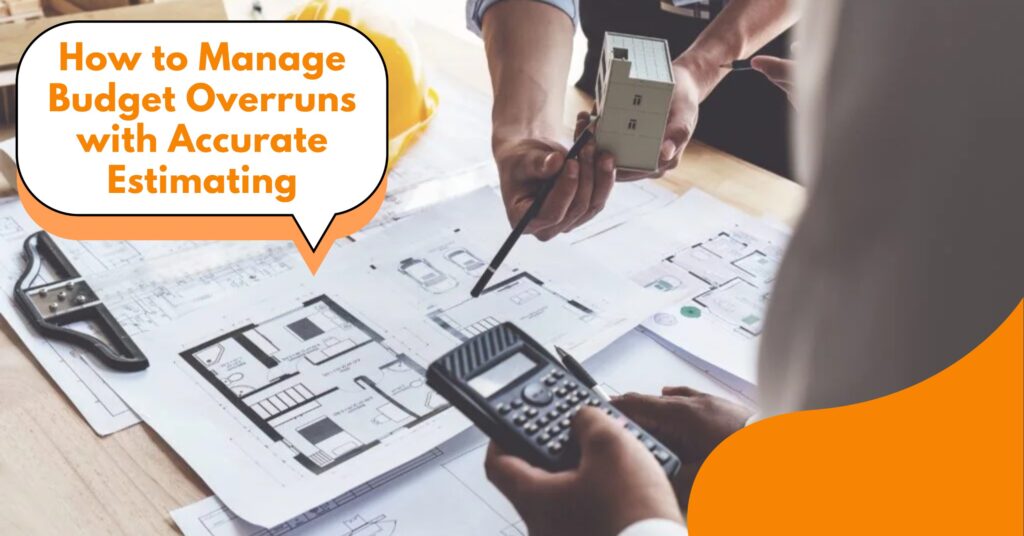Construction projects usually face the challenge of costs that get out of control. You start with a great plan, but sudden expenses blow the budget. This happens to many teams, leaving owners frustrated and profits slim. The good news is that accurate estimating from the beginning acts as a strong shield. It detects risks early and guides smart choices to stay within budget. In this guide, we explore common reasons for overruns. We also show how precise estimates prevent them, and share practical steps to control costs at every step.
Common Causes of Budget Overruns in Construction Projects
Budget overruns strike when least expected. Studies from the Construction Industry show that over 60% of large projects exceed their initial budgets by at least 10%. Understanding the root causes helps you avoid them.
- Poor Initial Planning
Guessed bids or incomplete site surveys lead to surprises like hidden soil issues or utility lines. For example, a mid-sized office building in Texas faced a $150,000 extra cost because the bedrock was deeper than assumed.
- Material Price Fluctuations
Steel lumber or concrete prices can jump due to supply chain problems. In 2023, global events pushed material costs up by 20% in many regions, catching unprepared teams off guard.
- Labour Shortages and Delays
Skilled workers are hard to find, and weather or permit hold-ups extend timelines. Each extra week adds overhead like equipment rentals and crew pay.
- Scope Creep
Clients add features mid-project without adjusting the budget. A simple kitchen remodel turns into a full home upgrade, ballooning costs by 30%.
These issues merge fast. A McKinsey report notes that projects with weak early estimates overrun by 30%, more than those with solid ones. Spot them early and you gain control.

How Accurate Estimating Spots Issues Before They Grow
The fix starts early with sharp estimates. Good ones spot risks before shovels hit dirt. They guide every choice and keep spending in line. Think of an estimate as a project roadmap. Draw it right and you avoid detours.
Accurate estimates dig deep. Teams review past jobs’ site conditions and vendor quotes. They build in real numbers, not guesses. This uncovers hidden risks. For example, a detailed takeoff counts every nail and board. Software helps, but human checks catch quirks like tight access that slow crews. One Texas crew on a school job caught high water tables in their estimate. They added drains up front and ended 5% under budget. Some Key benefits are
- Spot risks fast: Catch labor shortages before you post job ads and avoid last-minute premium pay for rushed hires that can blow your budget in weeks.
- Lock in costs: Secure supplier prices to beat sudden jumps that hit when markets shift mid-build and turn fixed bids into losses.
- Set firm limits: Spell out the full scope so extra work needs signed funds and stops unchecked scope creep cold before it adds hidden thousands.
The Power of Contingency Planning in Cost Control
No plan survives contact with reality unchanged. Smart builders add contingency funds. Contingency acts as a safety. Break it into types that are known unknowns for Weather or permit delays you expect, and unknown unknowns for surprise finds like old utilities. Experts recommend 5-10% of the total budget for most projects, rising to 15% for complex ones.
Create a contingency plan early:
- Categorize Risks: Separate known unknowns like weather, from pure unknowns such as design changes. This creates clear buckets for different types of potential issues.
- Assign Amounts: Tie specific funds to each risk category. For example, allocate $50,000 for material hikes and $30,000 for labor delays.
- Track Usage: Log every withdrawal from contingency along with the reason. This prevents the fund from turning into a general slush pool.
- Review Regularly: Hold weekly meetings to check if risks have shifted. Adjust allocations as needed to stay aligned with current conditions.
Contingency works best with accurate base estimates. Overestimate initially, and contingency hides waste. Underestimate, and it runs dry fast. Tie contingency to estimates. Base it on historical data from similar jobs. This keeps it realistic, not a blank check.

Tips for Project Managers to Control Costs from Start to Finish
Controlling costs is a major challenge. You are the one in the driver’s seat. Take charge with these proven steps and keep every dollar on track from bid day to final punch list.
Start Strong with Detailed Estimates
Gather input from subs, architects, and owners. List every task and cost. Update as designs firm up.
Monitor Progress Weekly
Compare spent versus planned. Tools like earned value track if you gain or lose ground.
Communicate Openly
Hold daily huddles. Flag variances fast. One team in Chicago caught a plumbing error early and saved $15,000 in rework.
Negotiate Smart
Bulk buy materials or lock rates early. Build vendor ties for discounts.
Train Teams on Efficiency
Teach lean methods. Cut waste in time and supplies. A warehouse project shaved 8% off costs this way.
Review at Milestones
Pause at 25, 50, and 75% complete. Adjust forecasts. Celebrate wins to keep morale high.
Follow these, and overruns shrink. A PMI survey finds disciplined managers finish 15 percent closer to budget.

How ALM Estimating Ensures Projects on Track and On Budget
Ever feel like your estimates are solid on paper but fall apart once the build starts? You’re not alone. That’s where expert help steps in to bridge the gap. At ALM Estimating, we focus on precision from the first review. Our team dives into your plans using proven methods and up-to-date tools. We pull from real market data and past jobs to craft estimates that hold up under pressure. Take a recent warehouse project in Ohio. The initial bid overlooked rising steel costs. We reworked it with locked quotes and buffers ending 7% under target.
Key ways we make it happen:
- Detailed takeoffs with checks
We count every bolt and beam using software for speed, then add human eyes to spot site quirks like uneven ground that could add weeks and dollars if missed.
- Real-time market tracking
We monitor material and labour shifts daily so your numbers stay fresh against price swings, avoiding the 15% overruns from volatility alone. - Built-in updates and tweaks
Minor plan changes get free revisions, keeping bids aligned without extra fees and ensuring scope stays tight through every phase.
- Risk buffers that fit
We add smart contingencies based on your job’s risks, like weather in the Midwest or supply chains, so surprises don’t derail the budget.
- Ongoing tracking support
Post-bid, we help compare actuals to plans, flagging variances early for quick fixes that keep profits intact till the end.
Conclusion:
Budget overruns don’t have to be part of your story. They start with weak estimates, grow through poor tracking, and end with lost trust and thinner profits. But you now hold the full guide to spot risks early, lock costs tight, plan contingencies with purpose, and manage daily like every dollar is yours, because it is. Accurate estimating isn’t a nice-to-have. It’s the foundation that keeps foundations affordable, schedules real, and clients coming back. One sharp bid can turn a red-line job into a referral machine.
Ready to stop budget overruns from stealing your profits and peace of mind? Contact ALM Estimating right now for a free expert estimate review that uncovers hidden risks before they cost you. Get a 30% discount on your first estimate.
FAQs:
Q1. What is the top cause of budget overruns in construction?
Poor initial planning stands out as the biggest culprit in most failed budgets. Teams rush through early estimates and skip critical details such as soil testing, utility hookups, or local permit fees. One overlooked line item can trigger a chain of change orders that add tens of thousands before the foundation pours. A Construction Industry Institute analysis of 400 projects found that weak front-end planning caused 60 percent of all overruns.
Q2. How much contingency should I add to my budget?
Set contingency between 5 and 15 percent of the total contract value, depending on project risk. Use 5 percent for straightforward office remodels with stable ground and clear drawings. Bump it to 10 percent for typical residential builds and push toward 15 percent for coastal sites, unknown soil conditions, or heavy weather exposure. Base the exact number on historical data from similar jobs in your area to keep the buffer realistic and defensible.
Q3. Can software alone give accurate estimates?
Software speeds quantity takeoffs and applies unit costs in seconds, but it cannot replace human judgment. Programs miss site-specific challenges like limited crane access or quirky local codes. They also lack context from past jobs where a certain subcontractor consistently underperforms. Top firms run digital takeoffs, then layer on field experience, vendor relationships, and lessons learned to produce bids that hold up through closeout.
Q4. What if scope changes mid-project?
Require every scope change to come with a signed change order that details new work, added costs, and schedule impact. Update the master estimate and budget the same day. Share the revised numbers with the owner, subcontractors, and field leads so everyone works from the same page. This simple rule prevents small add-ons from snowballing into six-figure surprises and keeps trust intact.
Q5. How often should I check costs during a build?
Review actual costs against the budget at least weekly and use earned value metrics to measure progress. Compare the dollars spent to the percent completed every Monday morning. Flag any line item that runs 5 percent over forecast and dig into the cause before the next payroll. Projects that track weekly finish 18 percent closer to target according to a Dodge Data study of 300 contractors.
Q6. Do material price locks really help?
Price locks on volatile items like steel, lumber, and copper pay off big. Secure firm quotes for 60 to 90 days on any material that fluctuates more than 5 percent monthly. In 2023, lumber swung 25 percent in a single quarter, forcing unlocked projects into emergency buys at peak rates. A locked quote turns that risk into a fixed line item and protects profit margins from day one.
Q7. What role do subs play in estimates?
Subcontractors supply the most reliable numbers for their trades, so involve them during the bid phase. Ask for detailed breakdowns, not lump sums. Early input reveals hidden scope gaps like temporary shoring or specialty fasteners that general estimates often miss. Skipping this step leads to low-ball subs who later submit change orders that erase your contingency in weeks.
Q8. How does weather factor into contingency?
Pull ten years of local weather data and count average rain days, freezes, or high winds per month. Add one standby day for every two expected delay days, including crew lodging and equipment rentals. Projects in the Pacific Northwest routinely build in 8 to 12 extra days per month during winter, while desert jobs focus on heat shutdowns. Treat weather like any other line item—quantify it or pay for it later.
Q9. Can accurate estimating improve client trust?
Clients trust transparent numbers they can follow. Provide a clear breakdown that ties every dollar to a specific task or material. When owners see exactly where funds go, they approve legitimate changes faster and fight fewer deductions at closeout. One mid-size GC cut payment disputes by 40 percent simply by handing clients a one-page summary of the estimate tied to the schedule.
Q10. Where do I start to improve my estimating?
Begin with a postmortem on your last three completed jobs. List every variance between bid and actual costs and tag the root cause, design error, market shift, or crew inefficiency. Turn the biggest wins into reusable templates and train the team on the process. Run the new system on your next bid and measure the gap. Most firms see accuracy jump 10 to 15 percent after the first audit cycle.
